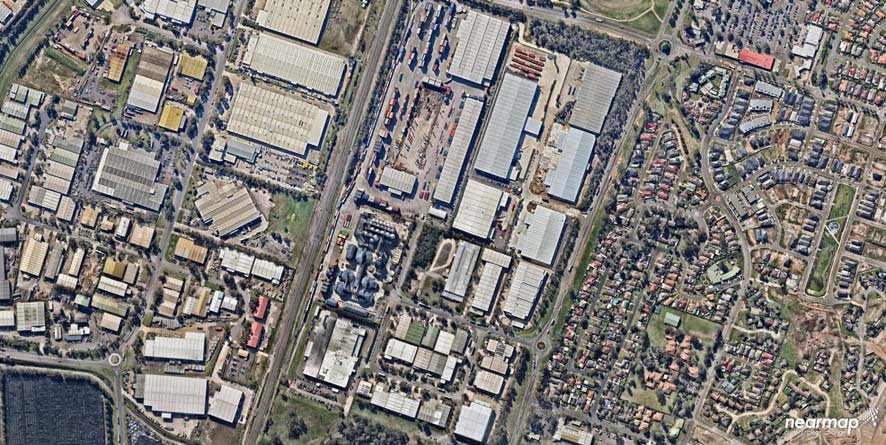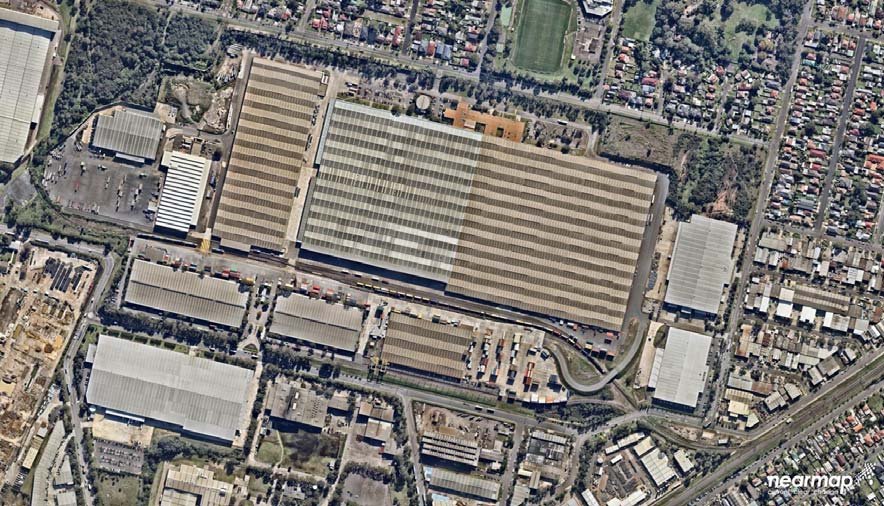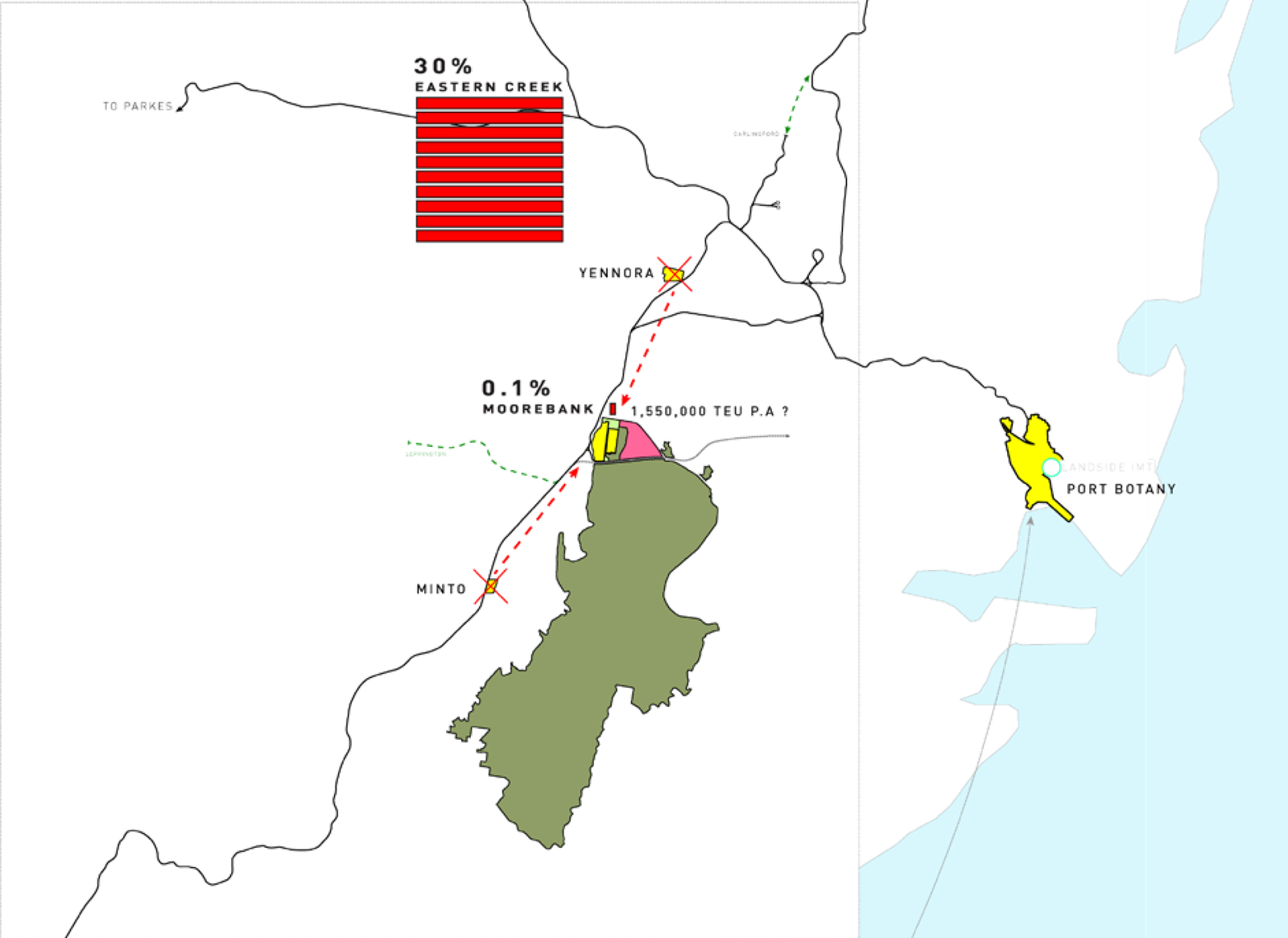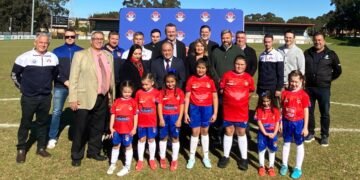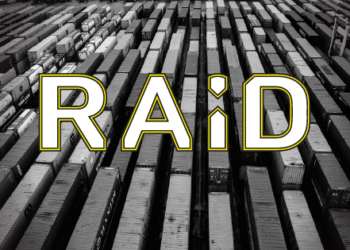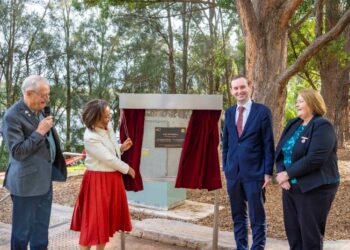Billion-Dollar Boondoggles in the Making!!
In a fiery discussion on 89.3 2GLF’s The Pulse on 21st August, Eric North from Residents Against Intermodal Development (RAID) Moorebank returned to unpack the next chapter of the controversial dual Moorebank Intermodal Terminal (MIT) projects—developments that only are minimally operational but have already reshaped the city of Sydney, state and national planning, and of course the lives of generations of local residents and the broader south west.
Speaking with me, Eric did not hold back, reaffirming that the projects have been driven by private interests and political games rather than anything resembling the public good; and with a staggering price tag for taxpayers. “Our best guess, is that, to date, about $5.5 billion in public assets, funds and other infrastructure have been consumed to make the Moorebank Intermodals possible. Not successful, just possible,”1 North revealed, leaving listeners stunned at the scale of investment.
But for local residents, this isn’t just a distant policy debate or wasted billions—it represents a looming and disastrous change to daily lives, health and amenity, and because the show aims to keep the community informed we’ve decided that we’re going to share as much as we can here on Local Pulse Press as a bit of an investigative series. So I urge all to listen back to previous episodes and continue to listen in as we uncover deeper layers of complex and troubling detail.
Substantive Democracy and Corporate Capitalism don’t mix
North was quick to challenge the assumption that what’s good for big business is good for the community. “I must fervently emphasise that what’s good for business in general and what’s good for big business in particular is not automatically good for government or the public interest,” he stressed. “It can be, of course it can be, but odds on bet, if you gave me a plan proffered by big business, I’d be able to show you how [all or part is] not just bad, but antithetical to public interest and exploitative of the average citizen, as is the case with the dual Moorebank Intermodals.”
As discussed last week “Moorebank is listed as just 1 of 23 recommendations in the FIAB report of 2005 [see image], which will have been directly influenced by the federal government announcement of Moorebank being added basically by fiat to the AusLink program in 2004,” 2 he explained, and cited in last weeks article. Thus having traced the projects’ history, North identifies both projects were ultimately and solely pushed without proper scrutiny let alone adequate science.
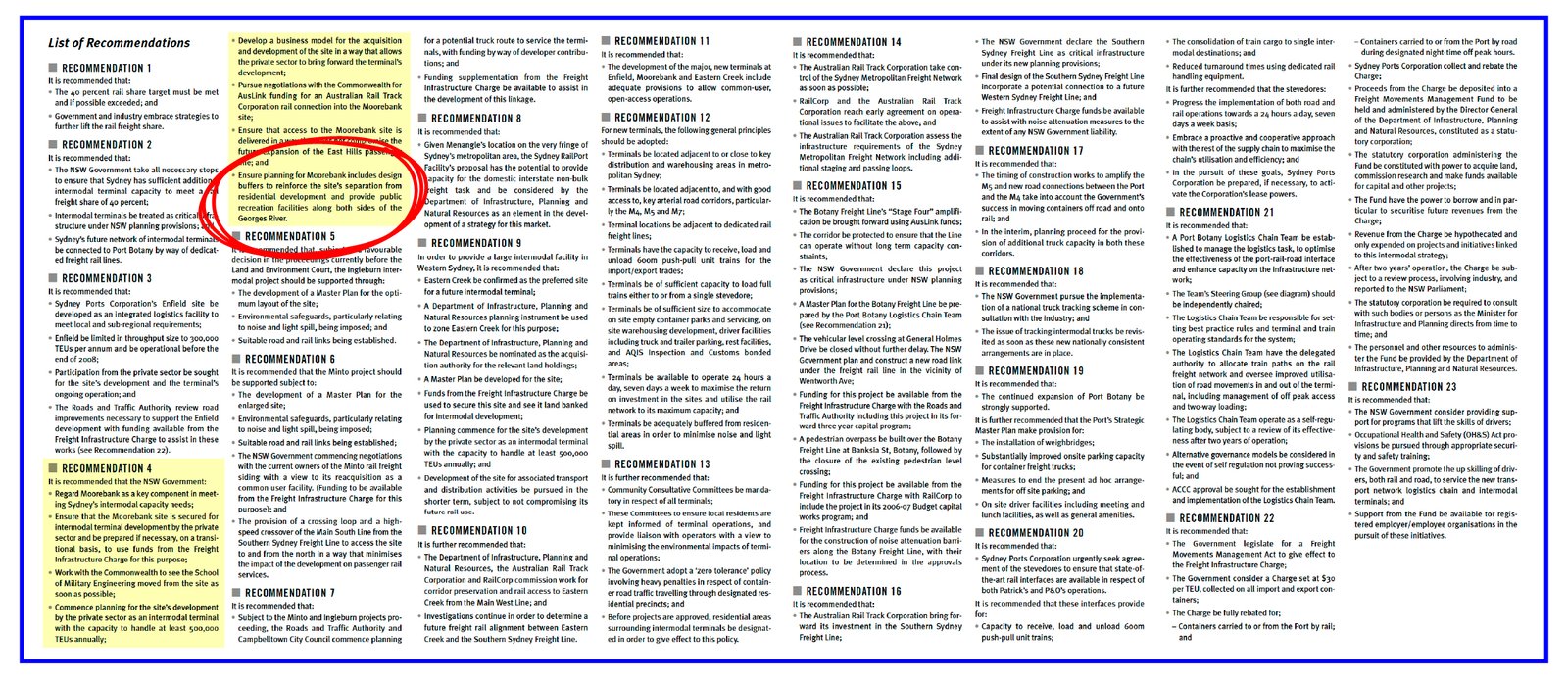
“There is no public evidence […] of any kind of due diligence, any kind of independent study or assessment at any point.” North also specified the political machinations behind the project, accusing both major parties of playing roles in its advancement. “In the main, the Liberal Party acted as kingmakers 3 […] and then you’ve got the Labour Party acting as cock blockers 4, whom later and is presently taking credit for Moorebank, which is an amazing turnaround,” he said. Specifically the 220ha federal intermodal terminal traces back to policies under Kevin Rudd’s government in 2007, with Infrastructure Australia created under Anthony Albanese (then Infrastructure Minister), now Prime Minster.
Prime Cockblocker
Albanese effectively added Moorebank to Infrastructure Australia’s priority list in 2009, not as an endorsement of Christopher Corrigan’s project but as a competing power play, which necessitated relocating the School of Military Engineering from the Moorebank side ti the Holsworthy side of the Barracks for a massive $870 million 5. Eric further argues that this strategic move to outmaneuver Corrigan, actually played into his Corrigan’s hands, both leading to the immense opportunity costs due to a lack of market-driven alternatives (e.g., Eastern Creek Intermodal, Western Sydney Freight Line and Port Botany rail duplication by 2010-15) and to a $1.67 billion-dollar-payday for Corrigan’s Qube Logistics. 6
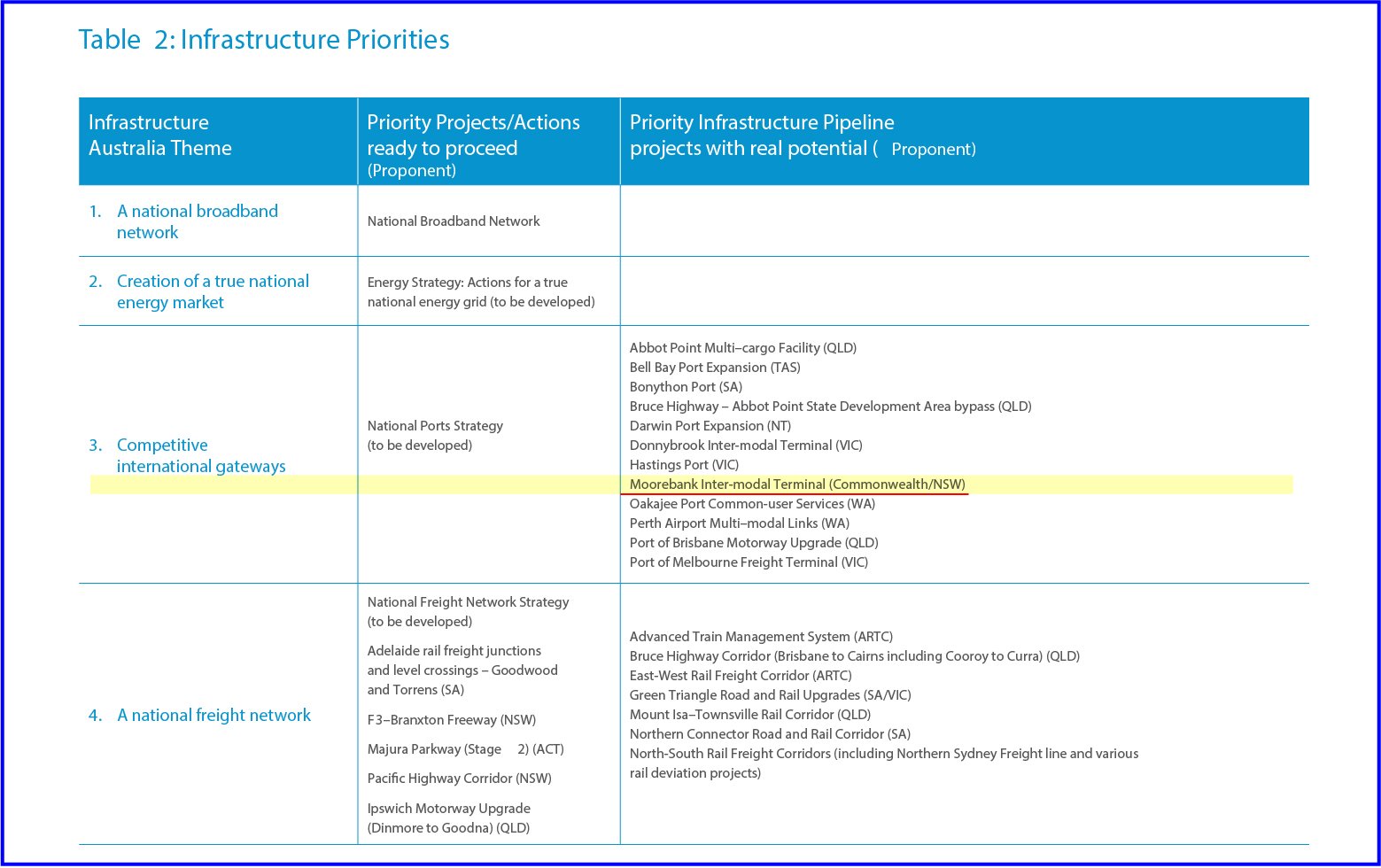
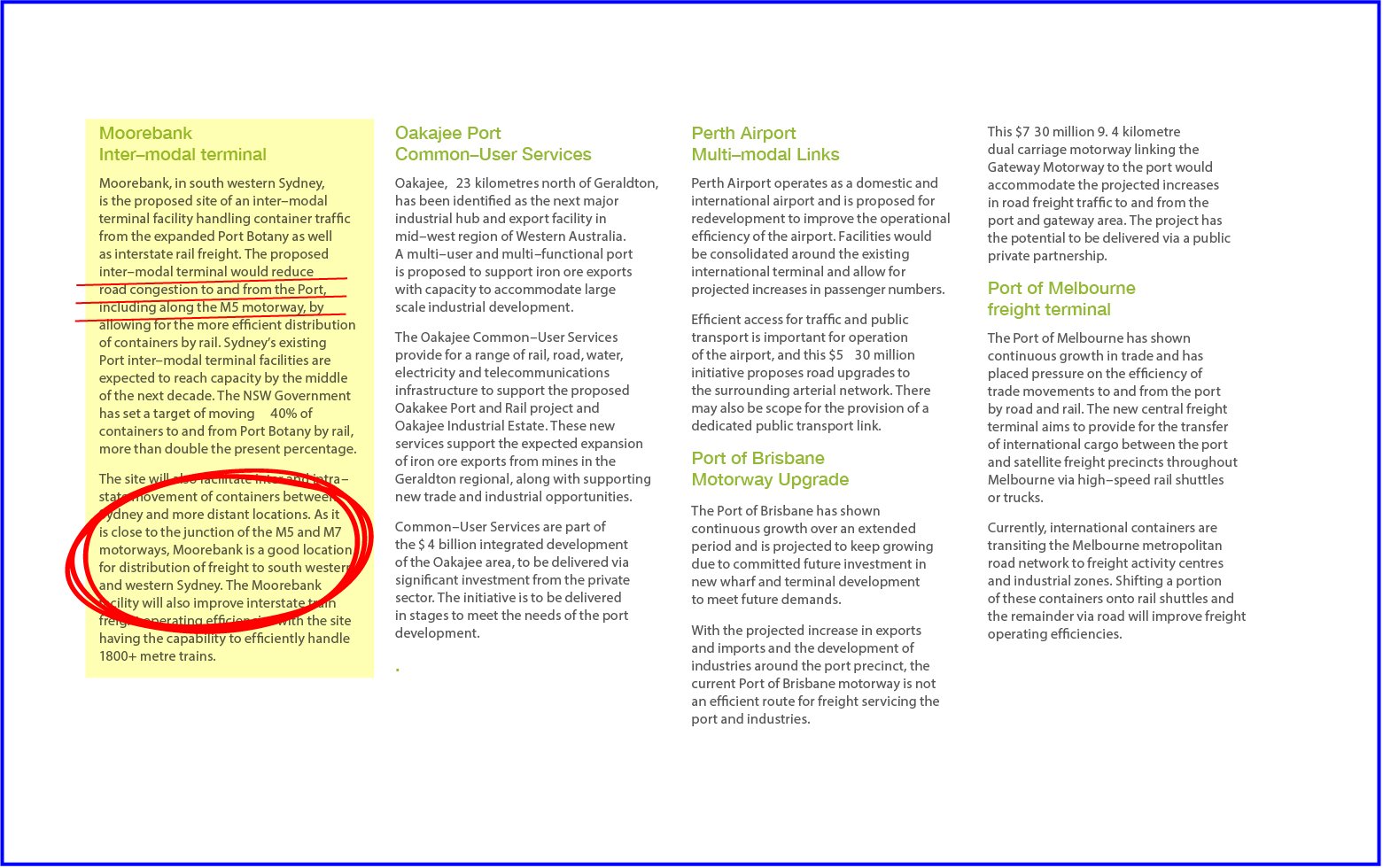
Up the Creek without a Clue
Around this, and at all levels of government, North suggests that politicians often fail to focus on the details, swallowing then regurgitating the ‘talking points‘, either due to personal mediocrity or ambition; and or the desperate need to be ‘announcing projects’; to seem relevant or to educate their electorate what they actually look like by way of mainstream media. Eric also commented on extremely busy, split-focused politicians who only ever have time for top-line talking points on their way to re-election or attacking the opposition, and thus simply don’t pay enough attention to or simply don’t care about the detail. And “sometimes it’s actually hard to tell which is which, what’s mediocrity and what’s malfeasance,” he remarked.
There were however some outliers, such as Independent Liverpool City Councillors Peter Harle, then Karress Rhodes and as well as the then-federal-MP for Hughes, Craig Kelly who endorsed and or requested two independent reports from community 7 which analyse the technical studies produced from the 2010 onwards. Said reports confirming the major flaws in the chosen location. “By 2015-2016, it becomes clear the proximity to these oversaturated and congested road and rail networks… renders Moorebank not merely a poor location, but a bad location antithetical to state and federal policy goals and, of course, the public purse.”
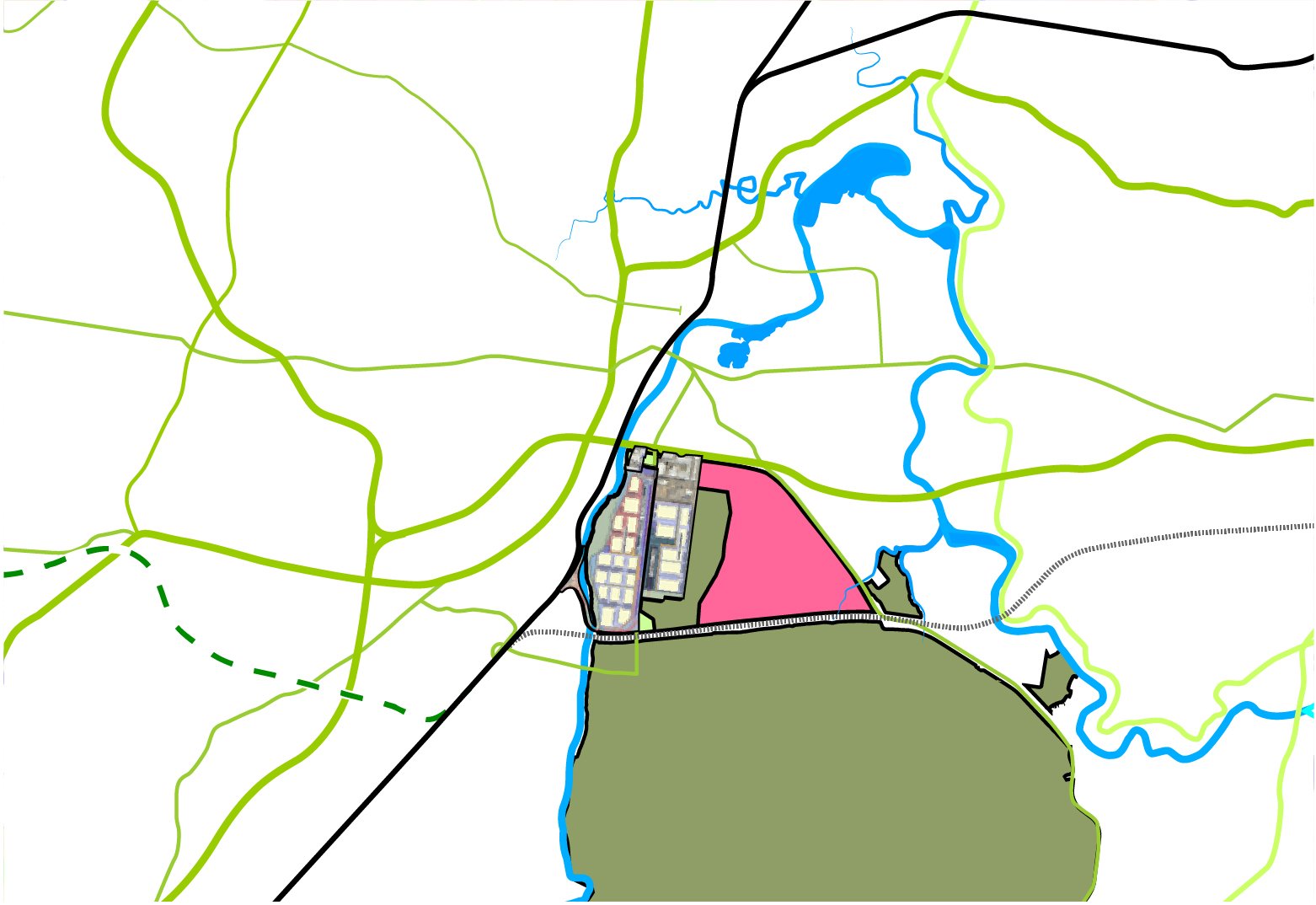
State Capture…
Eric then returned the spotlight to controversial businessman Christopher Corrigan, suggesting his personal ambitions drove the project forward despite its flaws8. “Corrigan had been kicked out of his own company and legacy,” 9 leaving old and new competitors in possession all other intermodals and assets in the market. As such “his only option then is to go all in on Moorebank.” Moreover a complex web of land deals and leases (of the former DNSDC) during the final years of the Howard Government basically ensured Corrigan’s resurrection was a “sure thing” with virtually “zero risk.”
To truly grasp why it might be the case that Corrigan was desperate to acquire the DNSDC at Moorebank, both to personally re-enter the logistics game, and to redeem his return on investment in the Liberal Party, you really must listen to the episode on demand and refer to paper that Eric cited: The Contract Regulation Club by Dabscheck (2006) 10. The paper lays out the nature of this neoliberal ‘club’ and its free market doublethink; by its advocacy for regulation that in turn ensured corporate deregulation and freedom for big business. Critically and specifically the paper lays out the relationship between Corrigan’s Patrick Corporation and the Howard Government and why it is that the latter might have ‘owed’ the former. Who wanted to consolidate his Yennora and Minto 11 assets to one location: Moorebank.
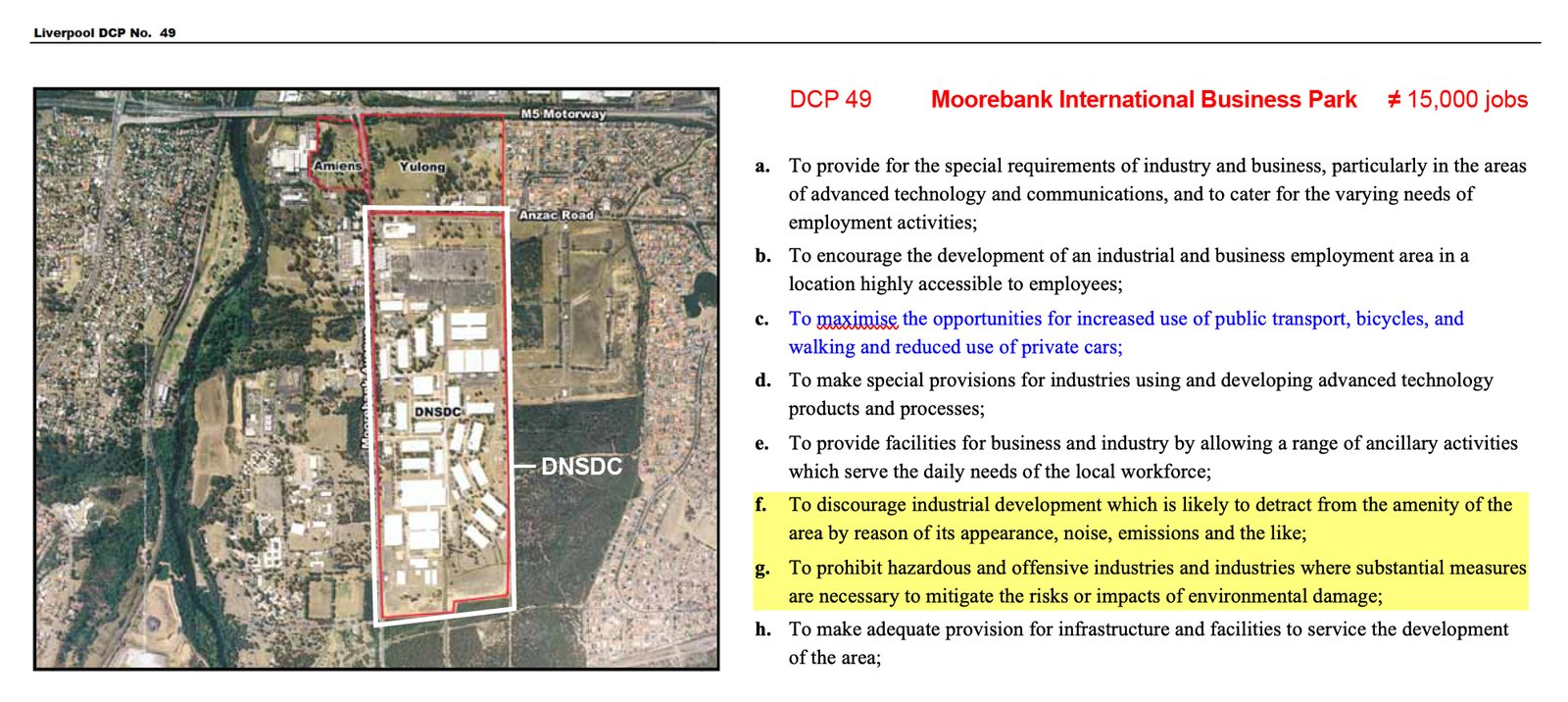
Note above, Liverpool City Council’s Development Control Plan 49 of 2003, set aside Amiens Park, Yulong Oval and the DNSDC for an International Business Park focused on “advanced technology and communications”. The intention was to deliver 15,000 jobs, with access to Casula Train Station and a new Train Station on the Airport Line, which could be joined by the long planned Casula Y Link (since 1998) 12 representing public transport access from three directions and parts of Sydney. Additionally and incredibly this plan was to “discourage industrial development which is likely to detract from the amenity of the area by reason of its appearance, noise, emissions”; prohibit hazardous and offensive industries and industries where substantial measures are necessary to mitigate the risks or impacts of environmental damage”; and make adequate provision for infrastructure and facilities to service the development of the area.”
What better descriptor of the dual Moorebank Intermodals is there? They are inimical to plans set out before any such Intermodals were announced. But with council put into administration between 2004 – 2008 Liverpool was without any community representation to fight for preexisting plans and better long terms visions for our river and our city. That is why it is so vital to Eric North explaining this all to us now as we possibly face another council forced into administration.
Nuts and Bolts
To recap on the past three segments recall that (a) an intermodal at Moorebank was shoehorned into federal policy in 2004 and thus made de facto NSW policy in 2005 (b) but the first Environmental Overviews for each project were not produced until 2010 (East) 13 and 2011 (West) 14 (c) and that evidence-based assessments in Environmental Impact Statements were submitted in 2012 (East) 15 and 2013 (West) 16 over a decade later after policy announcements. Resulting in not one but two competing intermodal projects (Eastern and Western) across the road from each other, slated to cumulatively consume over 300 ha of Georges Riverfront as shown in the images below.
The Eastern 83 ha Project
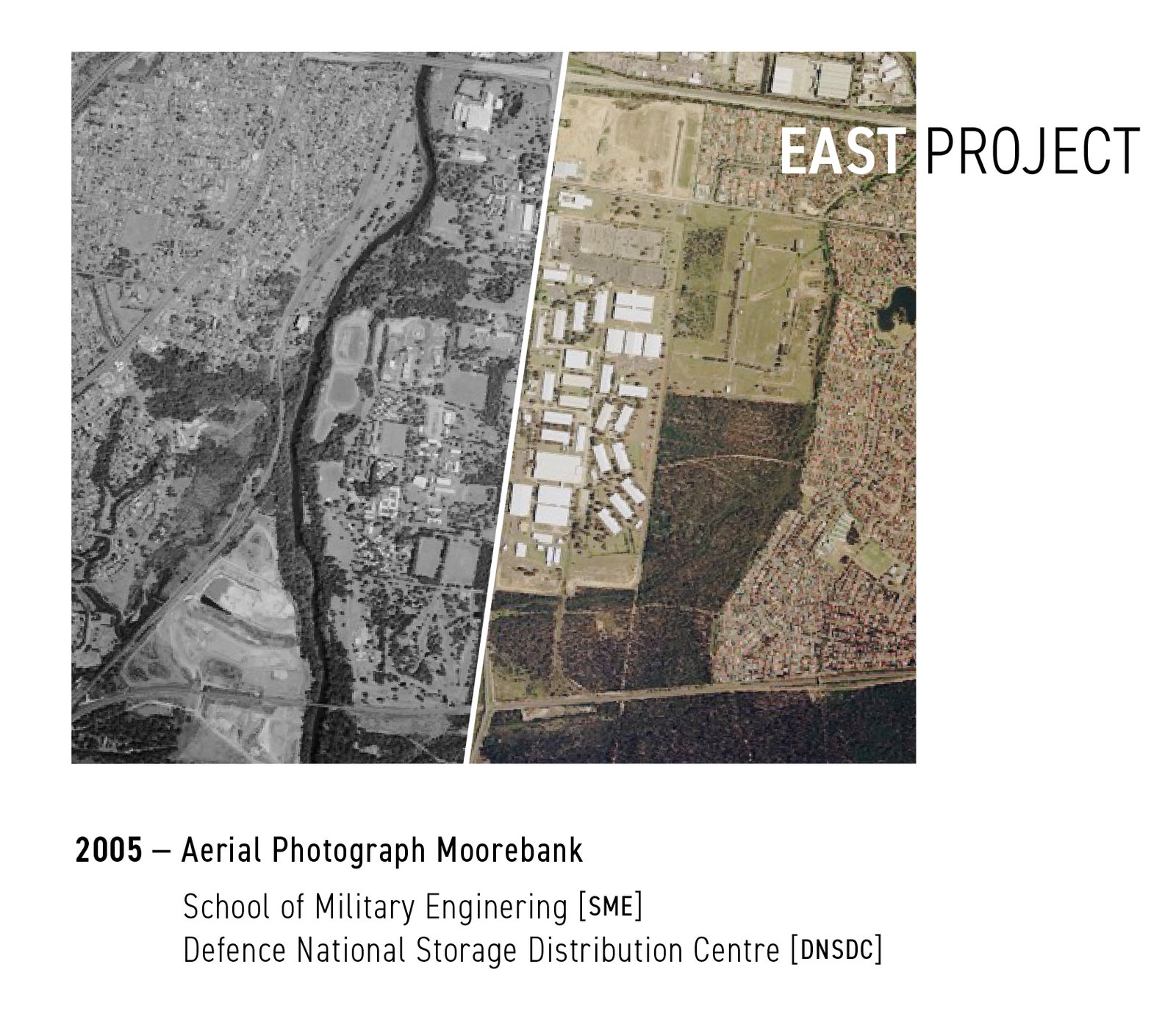
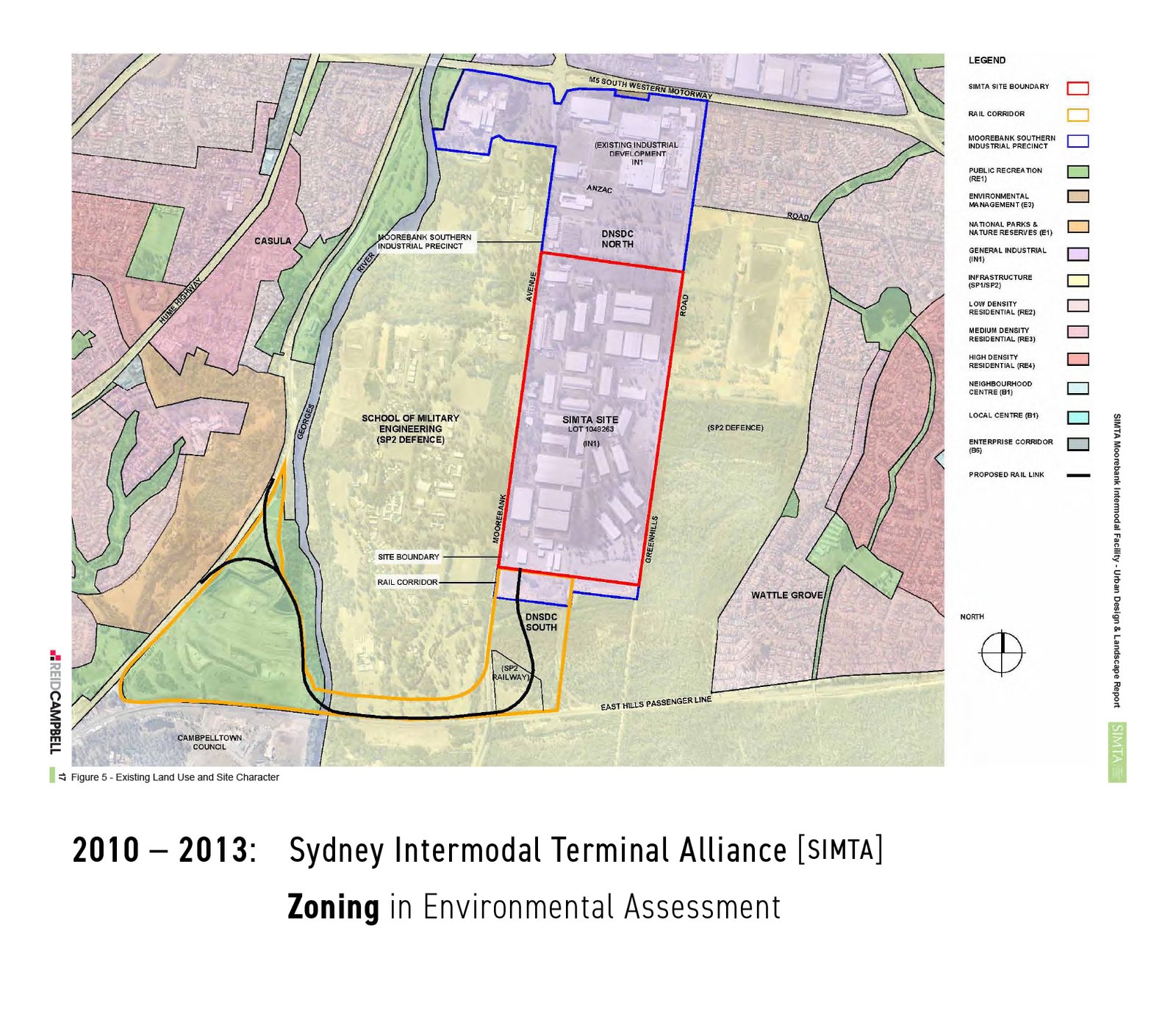
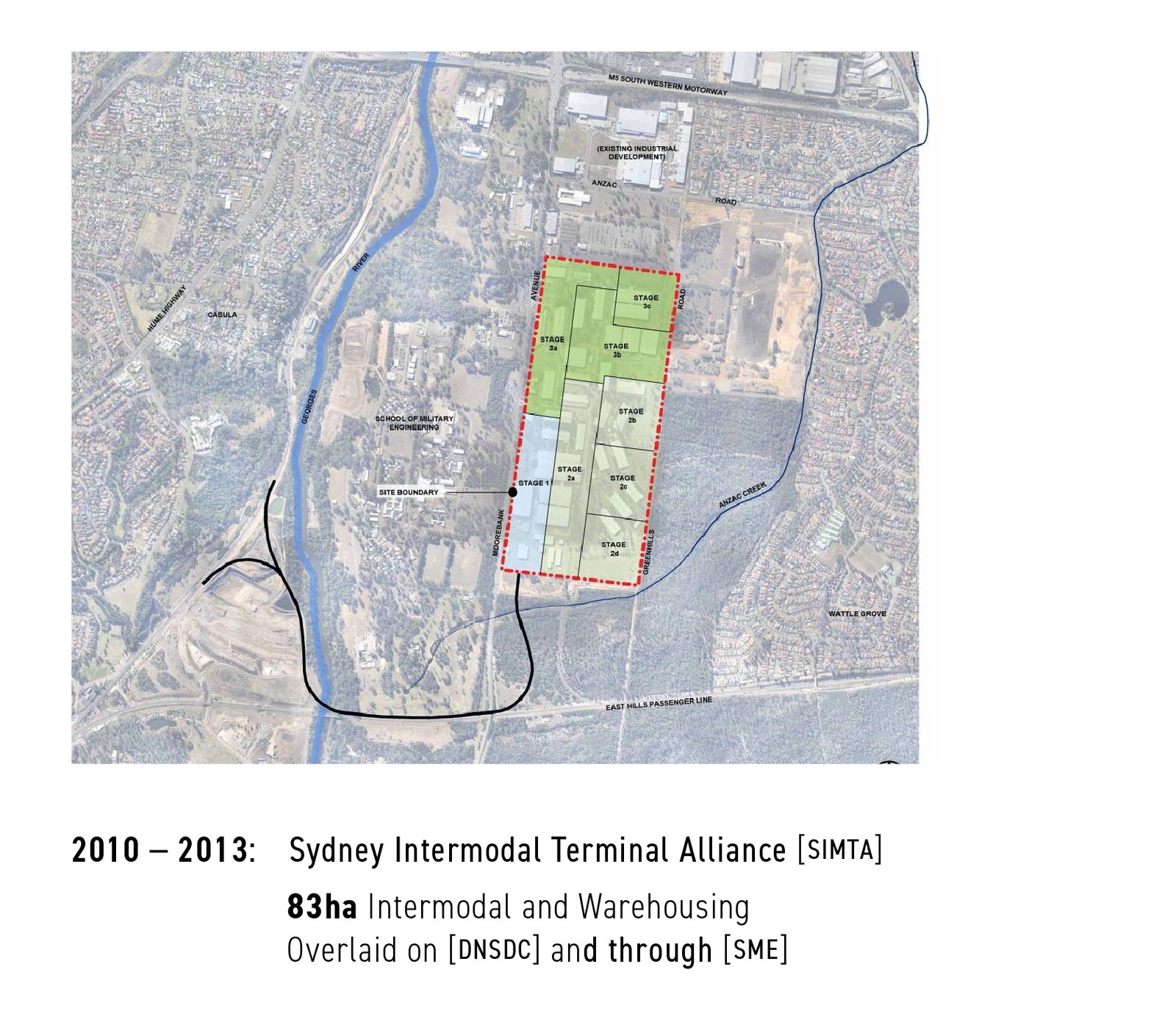
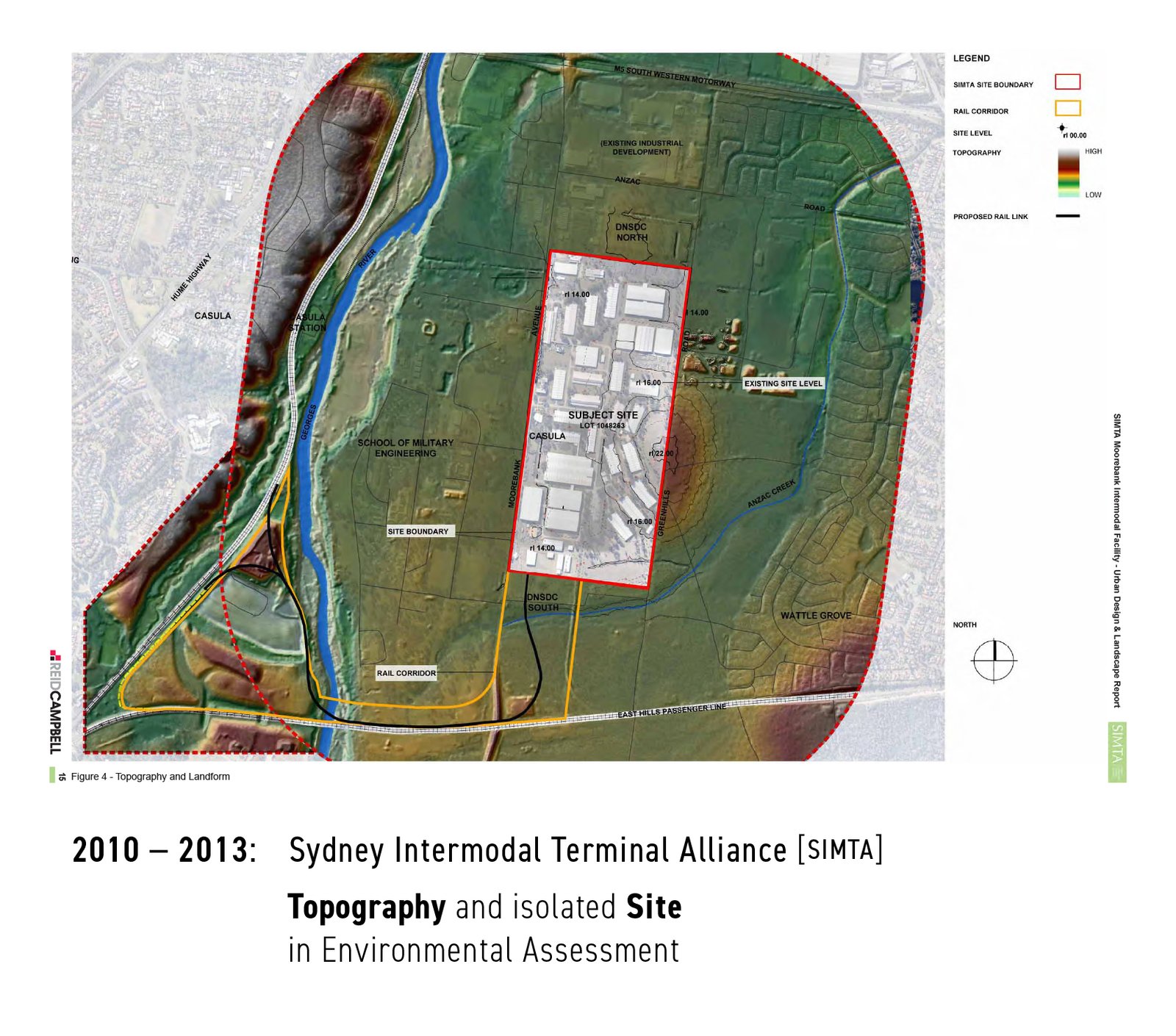
The Western 220 ha Project
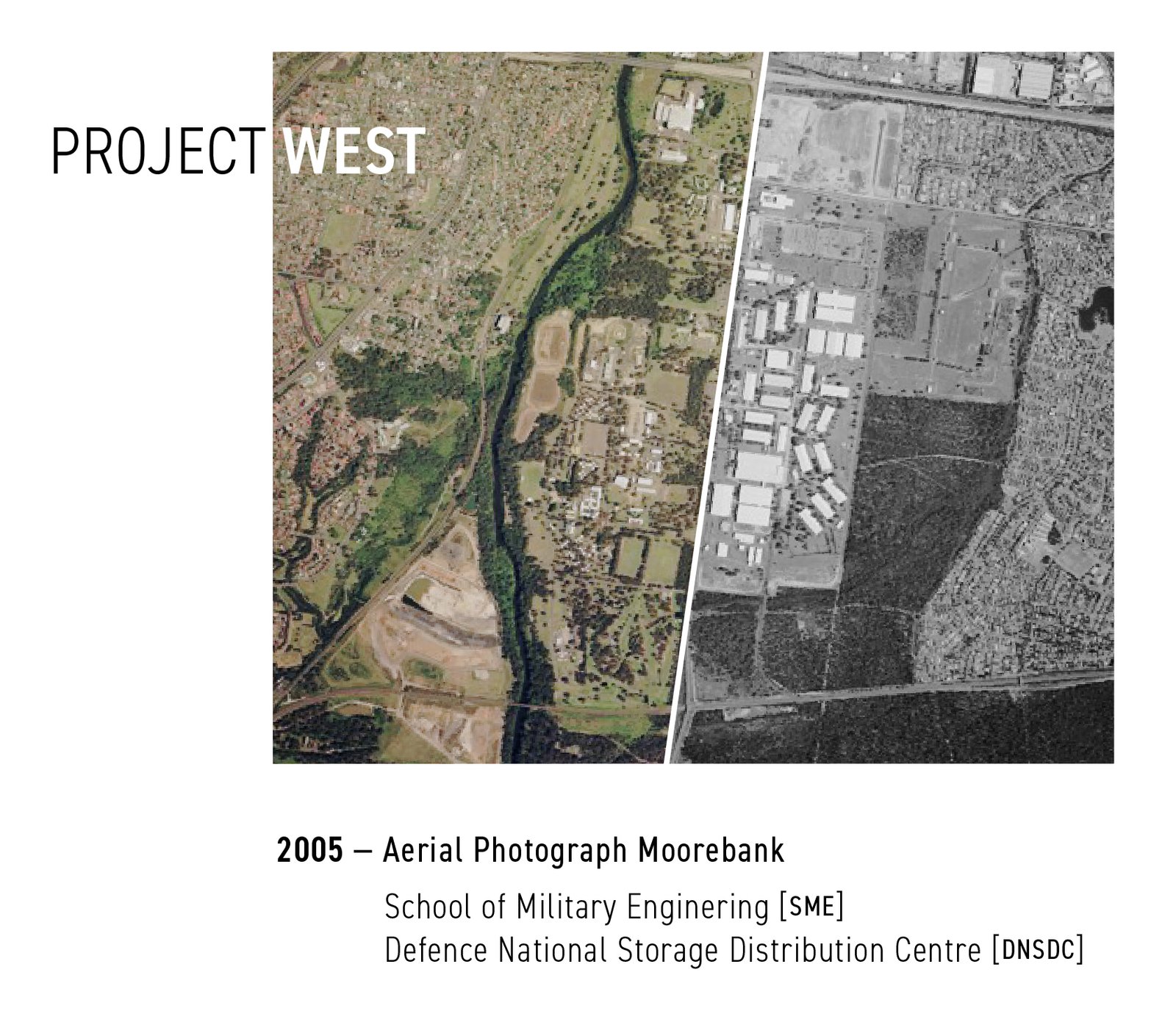
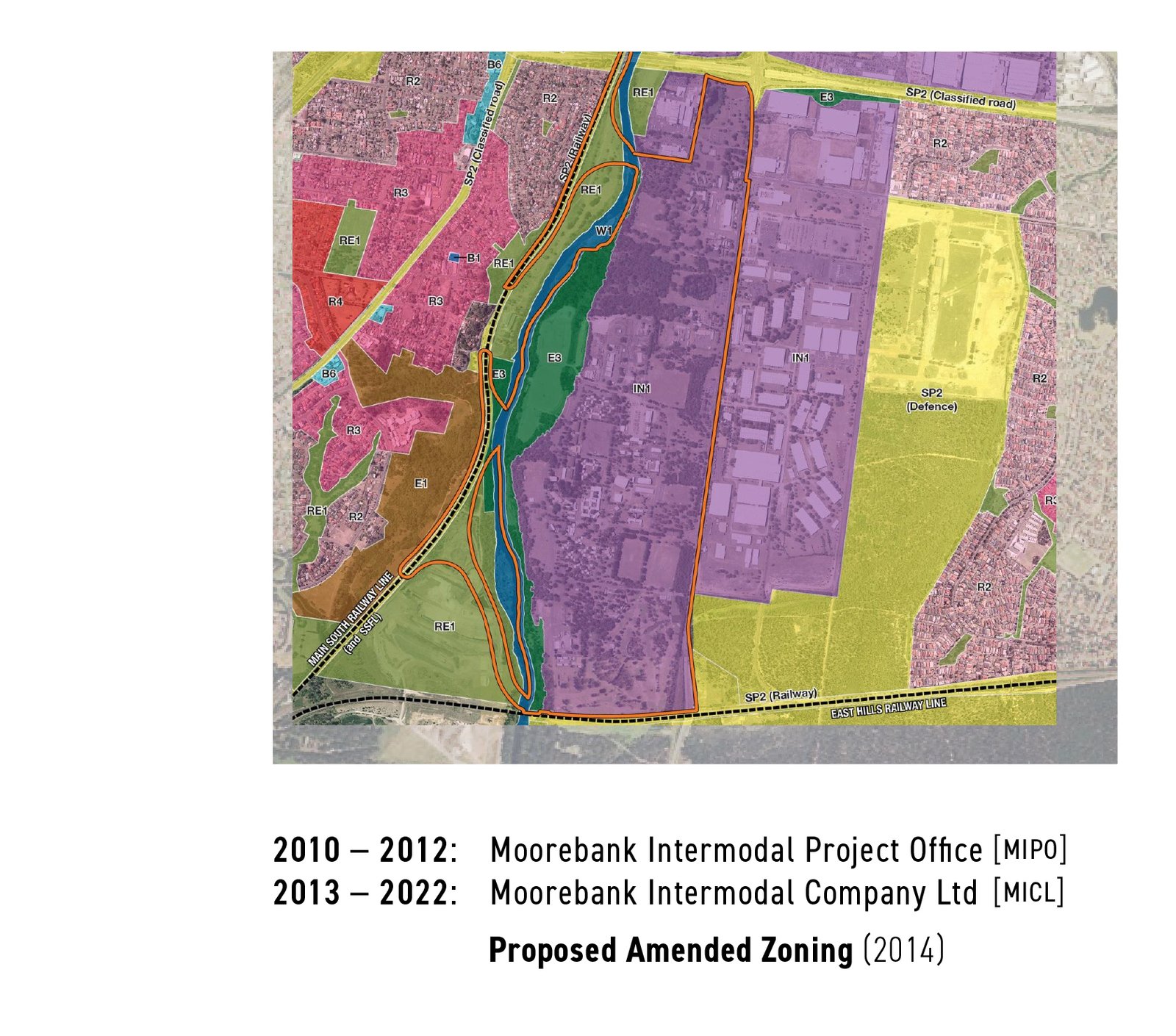
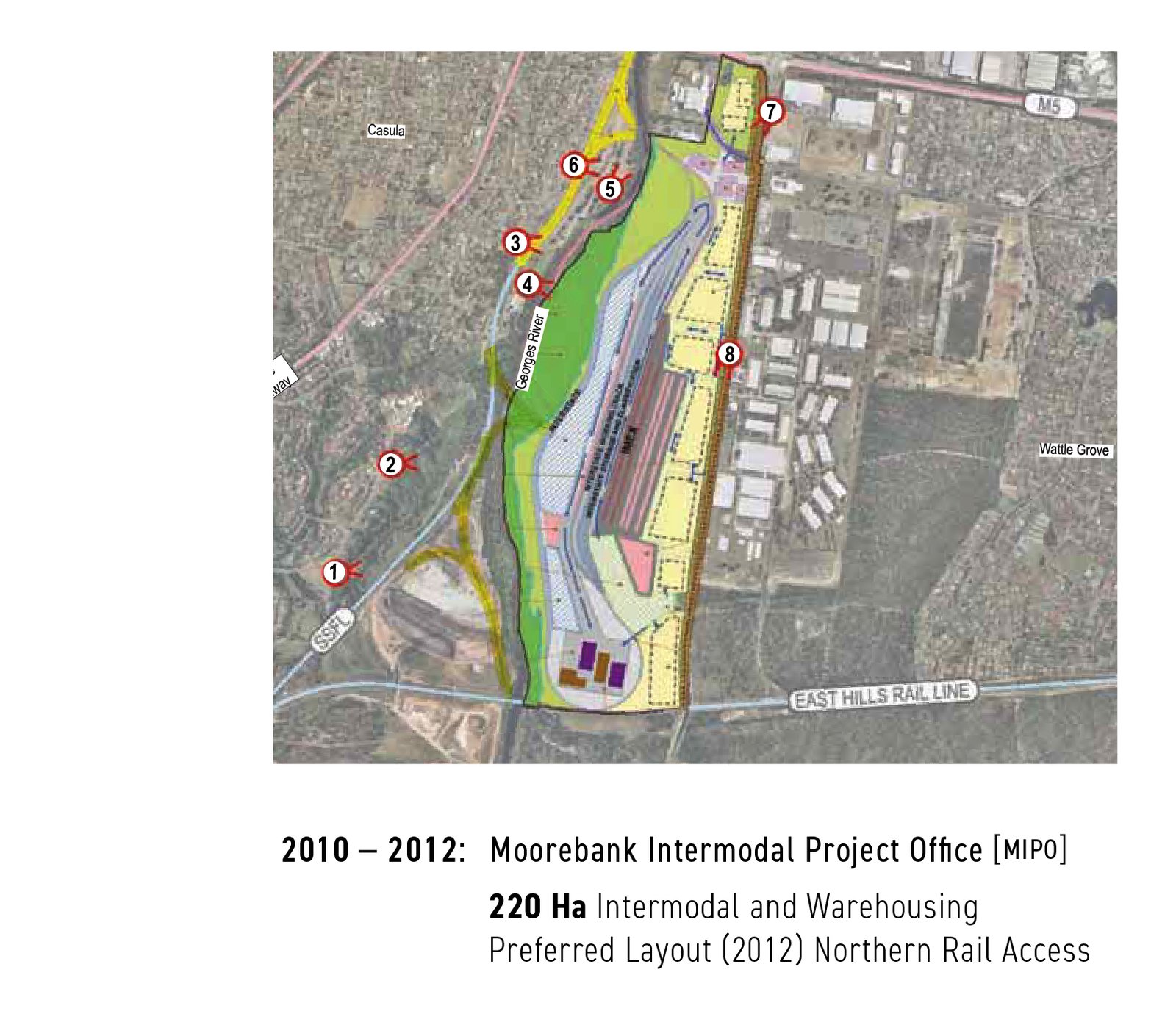
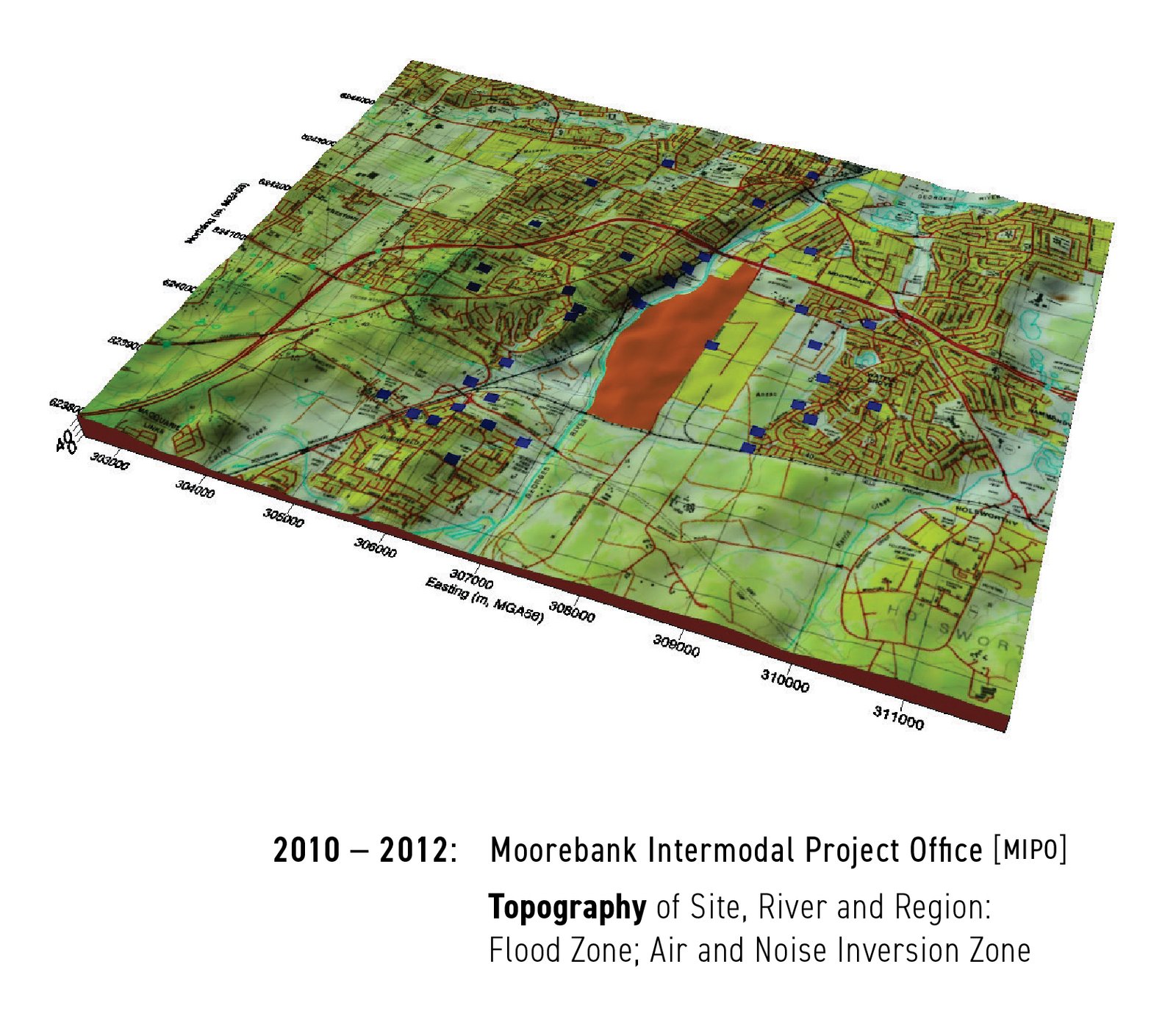
A CBD Worth of Waste
For those of you who do not live near or drive past the sites, Eric detailed a visual experiment for those listening and now reading. He asked to imagine the Sydney CBD and overlay of Moorebank Intermodals on Sydney Foreshore – emphasising the extreme magnitude of the real opportunity cost for Liverpool. The variant he explained on air would take out the Opera House, most of the Botanical Gardens and most all of East Sydney down to Central and up to Court House and beyond. As well as the CBD from Circular Quay, south to just north of Bathurst St, and west to the Western Distributor to the Harbour Bridge.
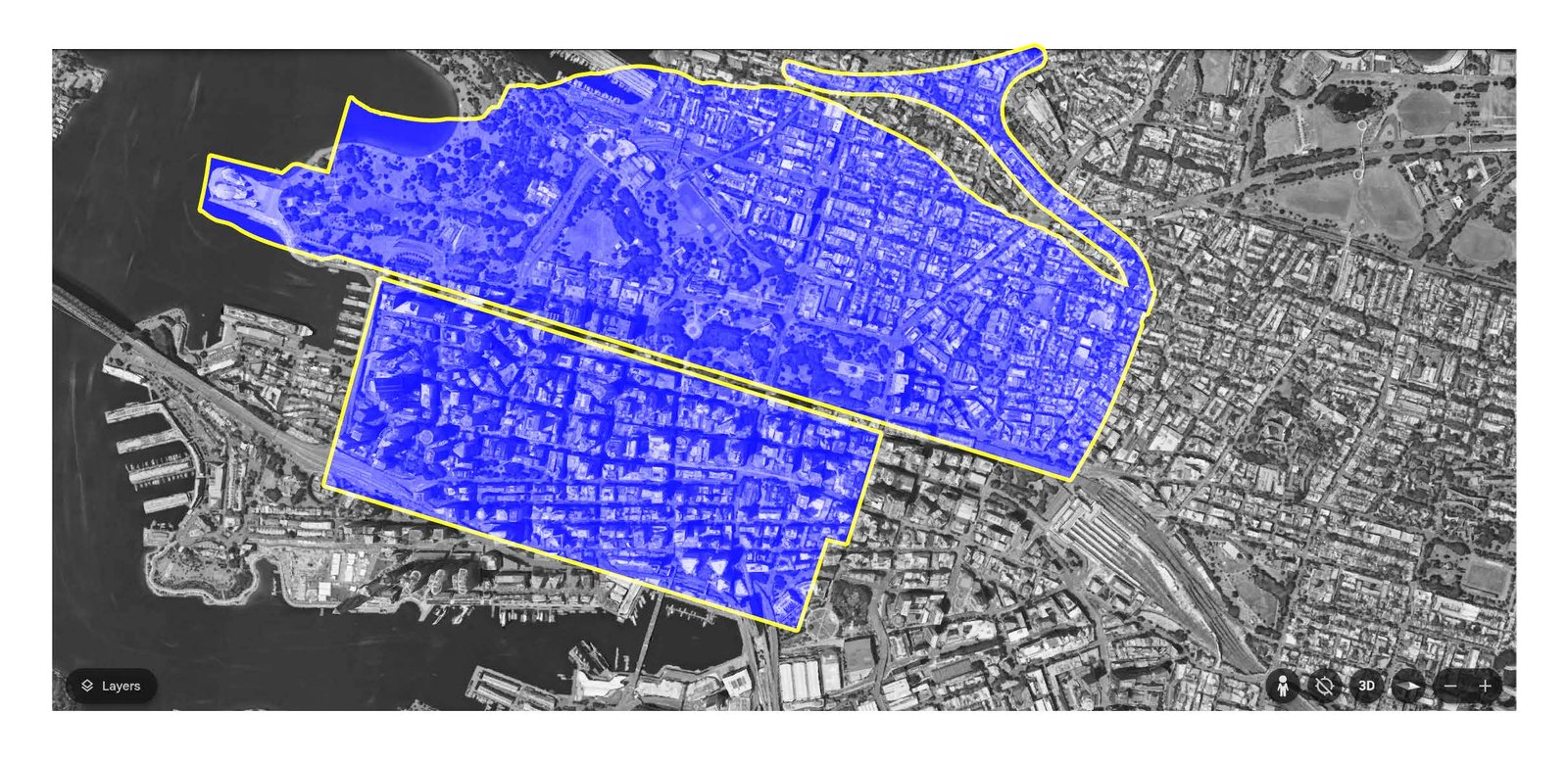
An alternate comparison that North put together to further express the magnitude of the largest intermodal terminal complex in the southern hemisphere was to literally place a variant in Sydney Harbour proximally adjacent to the Harbour Bridge so as to replicate how the projects; roughly the same size as Port Botany itself; would interact with the M5 Georges River Bridge. As below the dual Moorebank Intermodals intersecting the Sydney Harbour Bridge – would block the entire working harbour. Scrape off part of Admiralty and Kirribilli Houses, say goodbye to Pinchgut Island, Macquarie’s Point, with most of Potts Point and Garden Island gone and the Opera House narrowly surviving. Leaving all other lookouts and reserves with a front row view of this mechanical, metal, carcinogenic eyesore.
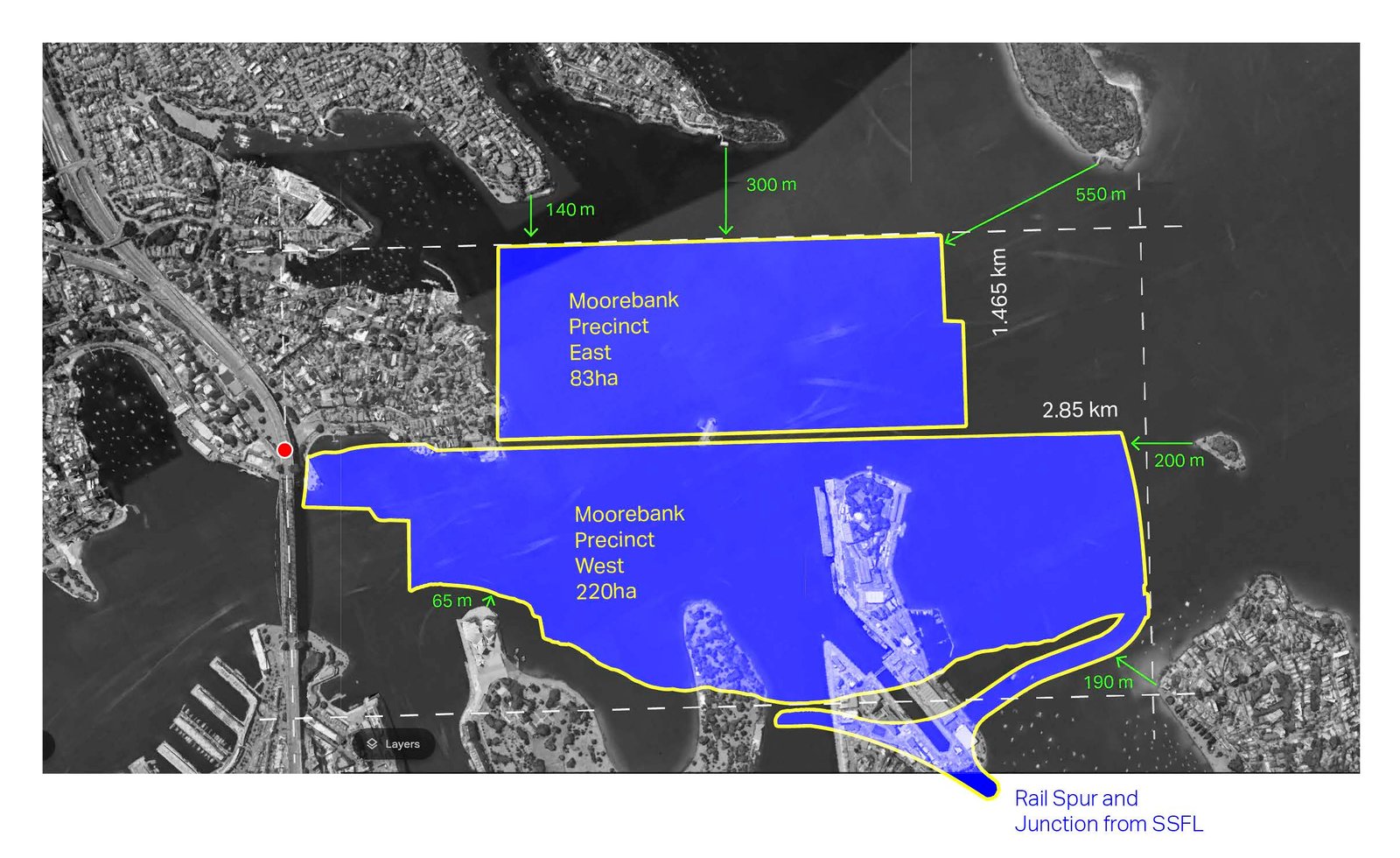
To ensure all listeners and readers can appreciate the immense scale and impacts to come, Eric has also shared with Local Pulse a further direct comparison of the Sydney CBD, Moorebank and Port Botany.
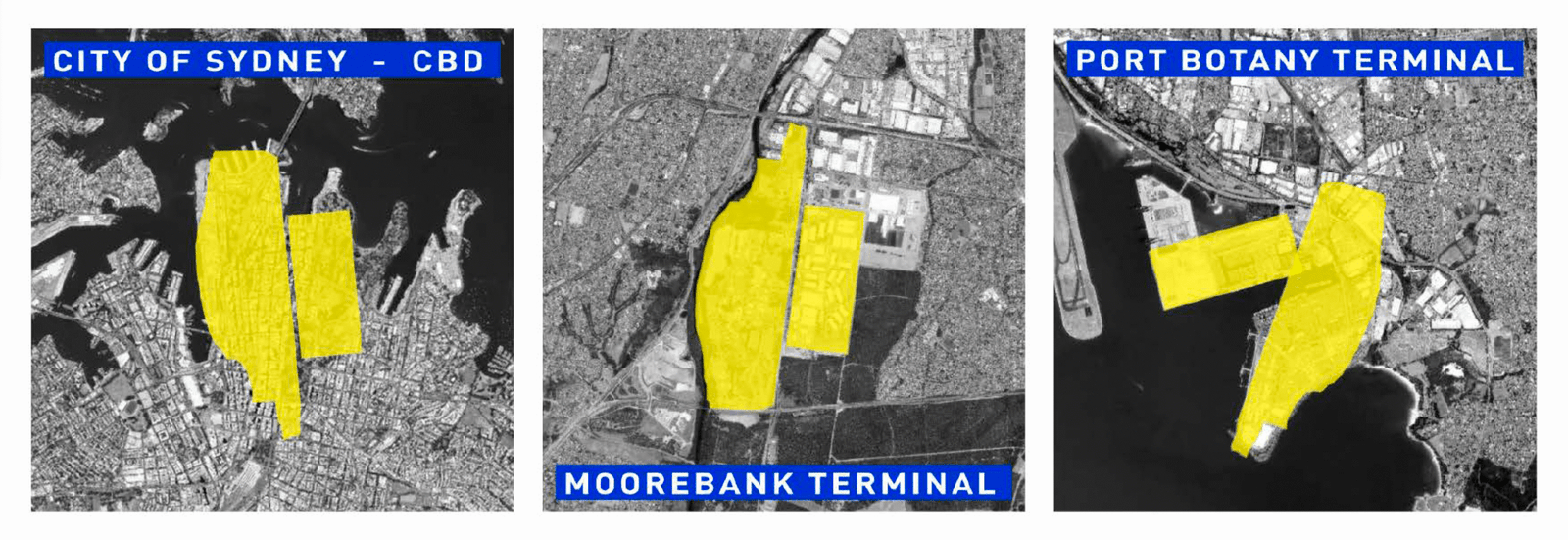
Once one factors in the Biodiversity Offsets or Biobanked Land required to achieve consent and the additional land required as a result of donating the old and building a new Moorebank Avenue closer to Wattle Grove; well over 400 ha of riverfront land has been sacrificed to this unholy white elephant. North also explained that the “biobanked land” is sterilised from human contact, we can’t access it, which, Eric went on to say means the original commitment to provide public recreation facilities along both sides of the Georges River is long forgotten, and that this is “just one many examples where governments of all levels have long ago forgotten most all of the promises, commitments, and conditions upon which project approval stands”, as he hinted at some whoppers to come.
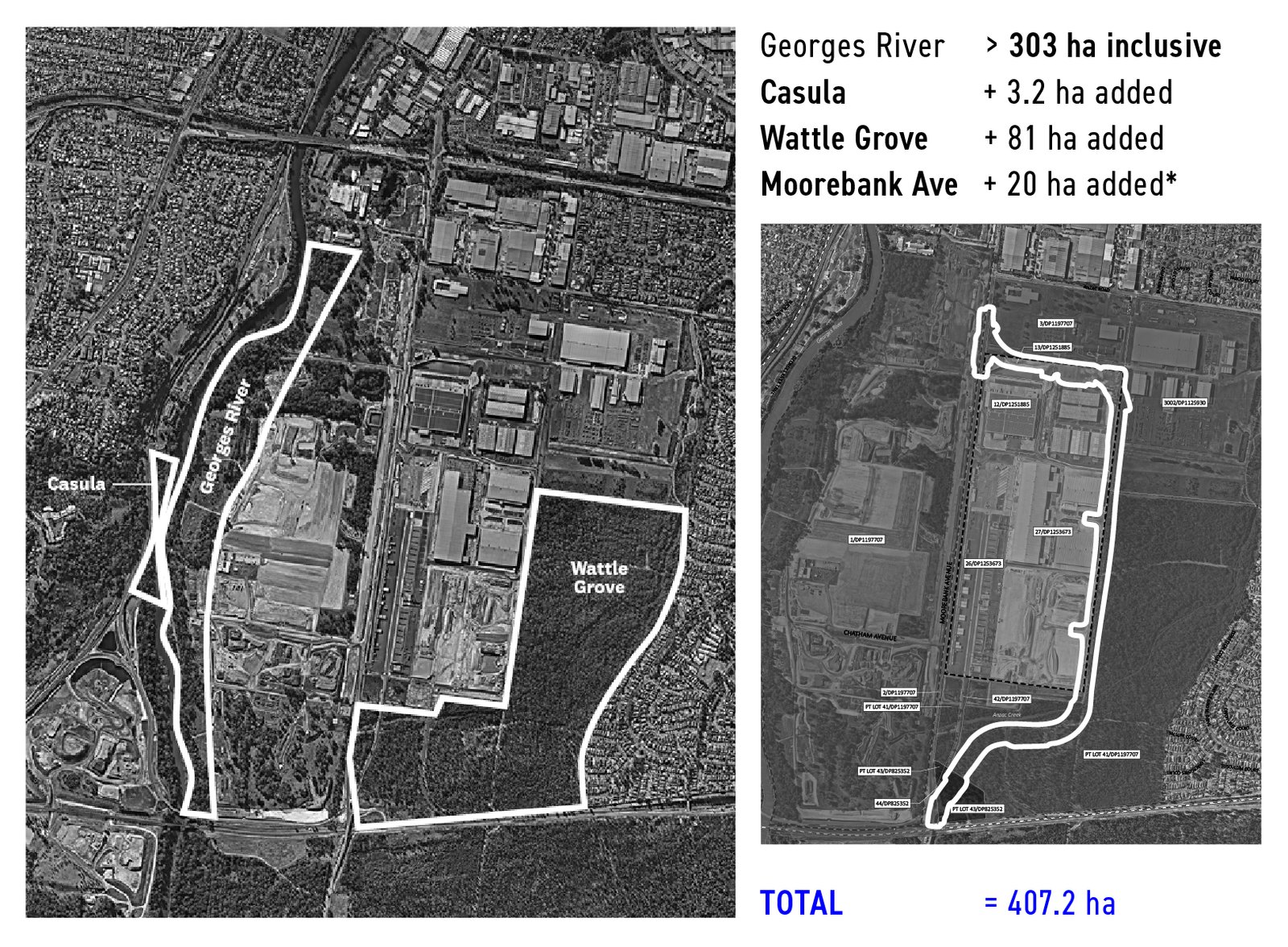
Project Parameters:
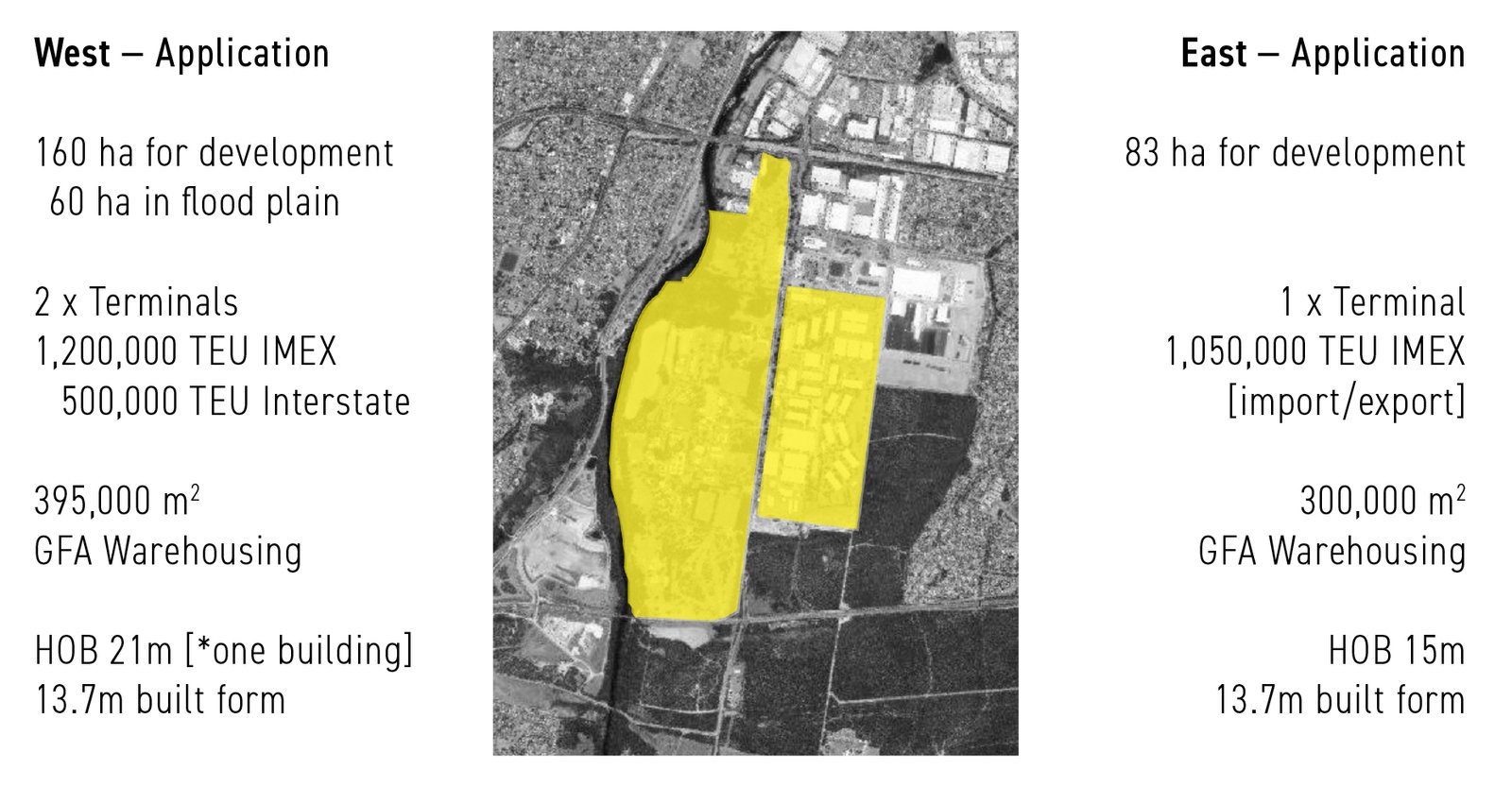
As at June & December 2016:
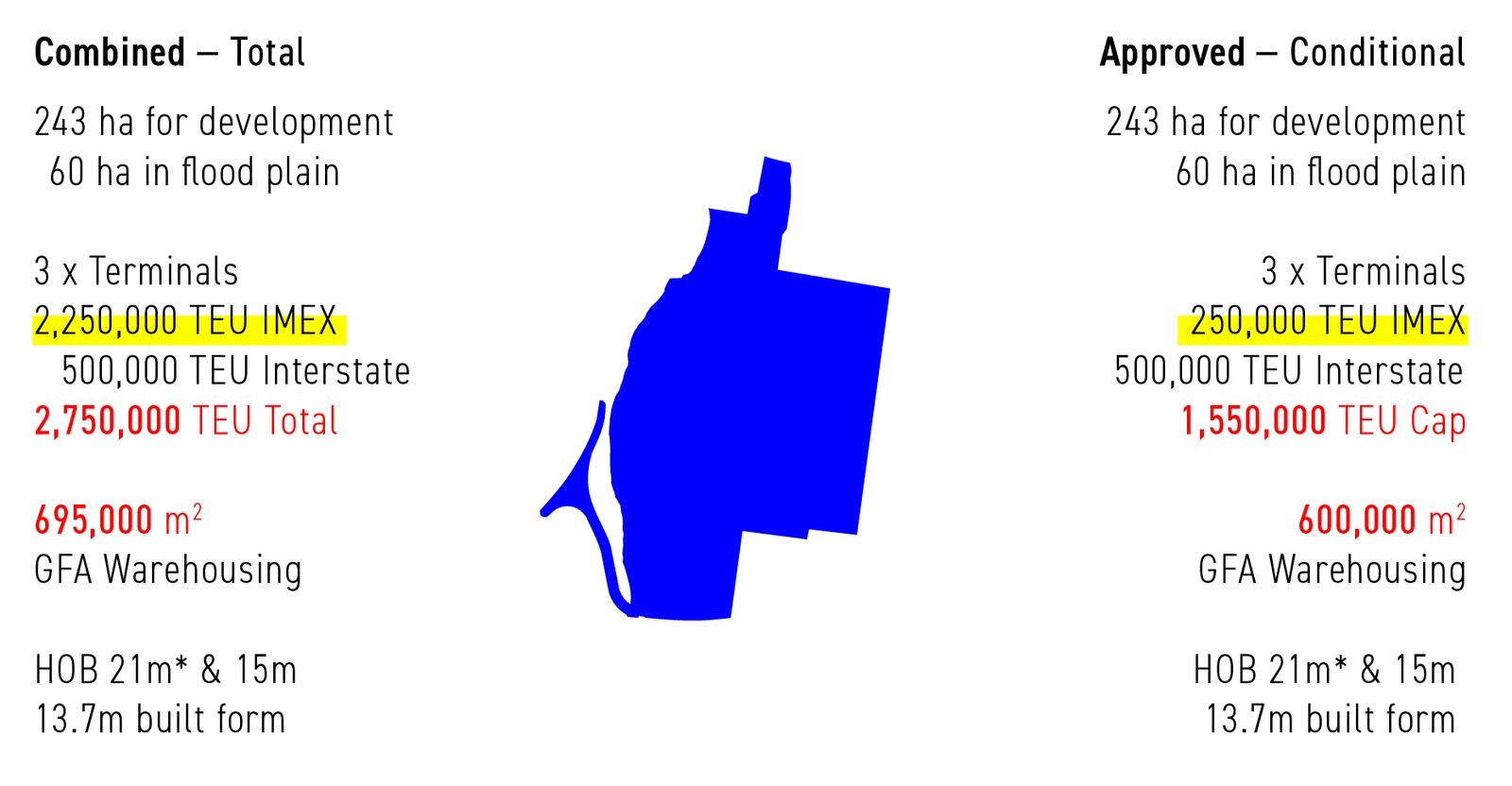
The impacted communities were told “one not both, buuuuut we got both” Eric lamented. The impacted communities were also told that Moorebank Ave would not be moved, a year later maps in both corporate and government pubic documentation showed Moorebank Ave as already realigned to the east. Per initial applications three terminals servicing 2.75 million TEU (twenty foot container of equivalent units) partially through 695,000 m2 of warehousing is the arithmetic total, and while an administrative cap of 1.55 million TEU was placed on the projects initially approved at 750,000 TEU (250,000 IMEX and 500,000 Interstate) and 600,000 m2 of warehousing, the reality is that the physical capacity of the terminals likely remains 2.75 million TEU. Which as it happens is more containers than is currently traveling though Port Botany itself.
Nevertheless, North explained that “those of us watching and tracking this closely are merely waiting to see how long it takes the federal and state government to ‘forget’ its own cap – just like it did when privatising Sydney Port Corporation [$$$]. Would Liverpool City Council keep looking the other way if this were to happen?
Footnotes:
- This figure of $5.5 billion+ comes from analysis done in 2017 and 2020 of publicly available government documents. It requires additional review and update which will, if anything, add to the total figure as more supporting assets, projects or funds emerge from further research. Additionally the figure relates to collating point-in-time costs and does not attempt to untie the knots of future year “discount rates” and the countervailing “multiplier effect”. The figure of $5.5 billion+ is also not an account of worst case “cost benefit analysis” nor “opportunity costs”. If and when these are also reviewed the former will be in the 10s of billions and the latter up to the 100s of billions–which is mindblowing. ↩︎
- Recall from last week that Moorebank is not mentioned once in either the provided Green or White Policy Papers of 2002 and 2003 respectively. ↩︎
- Dabscheck B. The Contract Regulation Club. The Economic and Labour Relations Review. 2006;16(2):3-24. doi:10.1177/103530460601600202.
Download here to access and note sections highlighted in blue. ↩︎ - East Liverpool Progress Association, submission – p4 onwards ↩︎
- Moorebank Units Relocation, identifies cost of $870,000,000 – p42, one of the inputs of Note 1. ↩︎
- see Urban Developer – “Australia’s Largest Logistics Park Sells for $1.67bn” , AFR – “Qube on the hook for interstate rail link” and Listcorp. – “Qube enters into Binding MLP Sale Documentation with Logos”, July 2021 ↩︎
- Download both reports on Moorebank Intermodals by Transport Modelling P/L (a) Key Assumptions Require Deeper Scrutiny (b) Better Options. ↩︎
- See timeline from 1998 to 2016 produced by East Liverpool Progress Association – p6 onwards ↩︎
- See SMH – “Toll tries to shunt Corrigan off board” and The Age – “Corrigan and his Patrick team take $37m toll.” ↩︎
- See Note 3 ↩︎
- See images below showing Minto Intermodal on the left and Yennora Intermodal on the right. Both sites in which Corrigan / Patrick Corp had had a stake. Both equidistant [as the helicopter flys] from Defence land at Moorebank. Identifying that SIMTA come Qube’s eastern project was not about capacity building but consolidation. That these sites would represent capacity building would be down to whether new owners maintained their use. That said, due the three sites having to complete for limited paths on the singular and constrained rail line consolidation is the likely default. Especially given that Qube would come to own a controlling stake in P&0 and half of Patrick Stevedores, as well as upstream intermodals at Botany and Cooks River allowing for near monopoly power and literally the inside track for rail freight – to feed the consolidation project at Moorebank. ↩︎
- See Action for Transport 2010 – p4 ↩︎
- Document: Sydney Intermodal Terminal Alliance [SIMTA] Preliminary Environmental Assessment – 2010, by Urbis. ↩︎
- Document: Department of Finance & Deregulation [DoFD > MIPO] Moorebank Intermodal Terminal Preliminary Project Environmental Overview – 2011, by Parsons Brinckerhoff. ↩︎
- Folder: SIMTA Environmental Assessment– 2012, by Urbis and Hyder. 52 assessment documents in the folder, only the first is necessary to establish date. ↩︎
- Folder: [MIPO >] Moorebank Intermodal Company Ltd [MICL] Moorebank Intermodal Terminal Project, Environmental Impact Statement – 2014, by Parsons Brinckerhoff. 82 assessment documents in the folder, only the first is necessary to establish date ↩︎
